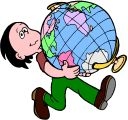
Worksheets and No Prep Teaching Resources
Reading Comprehension Worksheets
Geography

Geography
 Worksheets and No Prep Teaching Resources Reading Comprehension Worksheets Geography |
 Geography |
| edHelper's suggested reading level: | grades 5 to 7 | |
| Flesch-Kincaid grade level: | 6.13 |
|
History of Cartography
By Trista L. Pollard |

|
 1 Our view of the world has changed since 1500 years ago. The maps and globes we use today are very accurate. They show more details. You can see cities and countries. They show landforms and landmarks. Our maps now have a standard coordinate or grid system. This measurement system helps us to locate places on Earth. But what about the first maps? What are they like? How were they made? Let's take a journey into the history of cartography.
1 Our view of the world has changed since 1500 years ago. The maps and globes we use today are very accurate. They show more details. You can see cities and countries. They show landforms and landmarks. Our maps now have a standard coordinate or grid system. This measurement system helps us to locate places on Earth. But what about the first maps? What are they like? How were they made? Let's take a journey into the history of cartography. |
Create Weekly Reading Books
Prepare for an entire week at once! |
| Leave your feedback on History of Cartography (use this link if you found an error in the story) |
 |
Geography
|